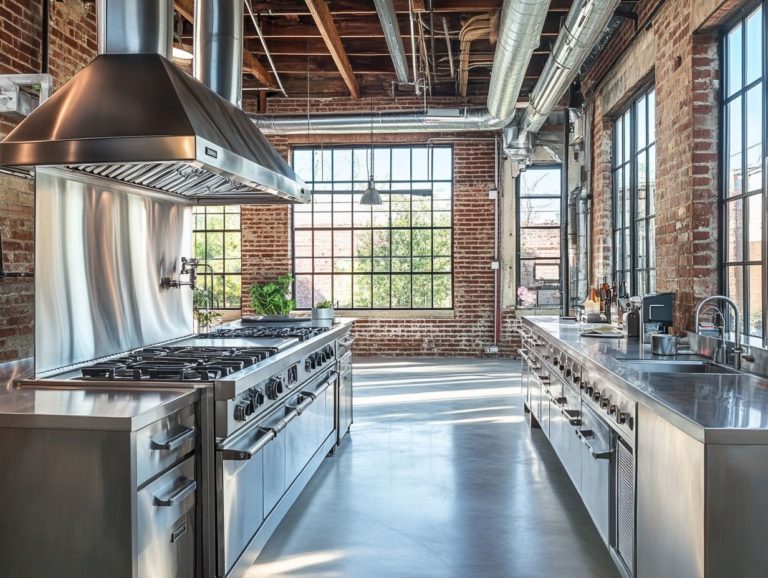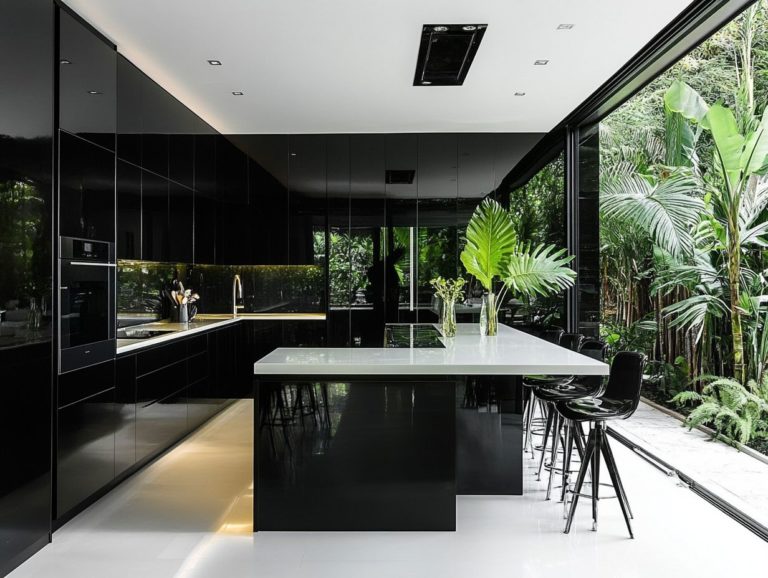Feng Shui Tips for Kitchen Design
Creating a harmonious kitchen is not just about looks; it’s about creating a space that feels good and enhances your well-being in one of the most vital areas of your home.
Get ready to dive into the essentials of Feng Shui! This guide provides you with practical insights for kitchen design, color selections, and materials that align with the five elements.
Uncover layout strategies that optimize flow and functionality. Master the art of effective appliance placement, and explore organizing techniques to banish clutter.
Let’s transform your kitchen together into a serene and inviting sanctuary.
Contents
- Key Takeaways:
- The Basics of Feng Shui
- Applying Feng Shui to Kitchen Design
- Choosing the Right Colors and Materials
- Layout and Placement Tips
- Feng Shui for Kitchen Appliances
- Organizing and Decluttering Tips
- Frequently Asked Questions
- What is the importance of feng shui in kitchen design?
- What are the key elements to consider when designing a feng shui kitchen?
- How should the stove be positioned in a feng shui kitchen?
- What colors are best for a feng shui kitchen?
- Are there any items that should be avoided in a feng shui kitchen?
- How can I incorporate natural elements in my feng shui kitchen design?
Key Takeaways:

Incorporate the principles of Feng Shui in your kitchen design to create a harmonious and balanced space. Use the five elements and choose the right colors and materials to promote positive energy and avoid negative energy in the kitchen. Optimize flow and functionality by carefully considering the layout and placement of appliances, and create a calm and clean environment through organizing and decluttering.
The Basics of Feng Shui
Feng Shui, an ancient practice steeped in Chinese philosophy, highlights the art of arranging spaces to cultivate a flow of positive energy, resulting in a harmonious environment.
By grasping its foundational principles, you can transform your kitchen—the heart of your home—into a space that amplifies energy, boosts productivity, and nurtures well-being.
Essential concepts include incorporating natural elements, decluttering, and following design guidelines that promote tranquility and spark creativity in your culinary endeavors.
Understanding the Principles
Understanding the principles of Feng Shui involves grasping concepts such as energy flow, the Bagua map— a tool that helps you see how different areas of your kitchen affect your life—and the five elements: Earth, Metal, Fire, Water, and Wood. These elements are essential for crafting a balanced and harmonious space.
These concepts interact intricately, shaping how your environment influences your physical and emotional well-being. The Bagua map acts as a valuable tool for evaluating different areas of your space, aligning specific sections of your kitchen with vital aspects of life, such as health and relationships.
When designing your kitchen, each of the five elements plays a pivotal role, either fostering vitality through warmth and nourishment or ensuring clarity and cleanliness with natural materials. For instance, incorporating a wooden dining table or metal appliances can significantly enhance energy flow and balance, resulting in a serene cooking environment.
Applying Feng Shui to Kitchen Design
Applying Feng Shui principles to your kitchen design means incorporating specific tips that maximize space utilization while elevating both the aesthetic and functionality of the area.
By thoughtfully considering your kitchen layout, you can craft a cooking environment that is not only visually pleasing but also fosters positive energy, leading to a more enjoyable and efficient cooking experience.
Creating a Harmonious Kitchen Space
Creating a harmonious kitchen space requires keen attention to detail, especially regarding how natural elements and lighting choices impact energy flow and the overall ambiance.
Thoughtfully select materials like wood, stone, and bamboo to cultivate a connection to nature that fosters tranquility and balance.
Effective lighting is essential; a blend of ambient, task, and accent lights ensures that every corner of your kitchen exudes warmth and functionality.
Embrace design elements that promote the free flow of energy—such as open layouts and uncluttered countertops—to contribute to a serene cooking environment.
Integrating Feng Shui principles, like positioning the stove in a commanding spot and opting for soft curves in furniture, can elevate your space, making it inviting while nurturing a calming atmosphere for everyone who gathers there.
Choosing the Right Colors and Materials

Selecting the right colors and materials is crucial for Feng Shui kitchen tips. Colors possess the remarkable ability to influence mood and energy, while the choice of materials plays a significant role in shaping the overall ambiance of the space.
Start creating your peaceful kitchen sanctuary now!
Incorporating the Five Elements
Incorporating the five elements—Earth, Metal, Fire, Water, and Wood—into your kitchen design creates a balanced environment that beautifully aligns with Feng Shui principles.
By thoughtfully selecting materials and colors, you can represent each element effectively, crafting a harmonious cooking space.
For instance, Earth is shown through warm, earthy tones like terracotta tiles or wooden countertops, promoting stability and nourishment.
Metal accents, such as sleek stainless steel appliances or elegant light fixtures, introduce clarity and focus to your kitchen.
The element of Fire is represented with vibrant pops of red or orange in your decor. Water flows through blue hues, glass features, or a stunning sink.
Wood can be integrated with natural finishes in cabinetry or by growing herbs in charming pots, adding a lively touch to your space.
When these elements are balanced, you not only elevate the kitchen’s aesthetics but also foster a positive energy flow that uplifts creativity and well-being while you cook!
Avoiding Negative Energy
Avoiding negative energy in your kitchen is key to cultivating a tranquil and productive cooking environment. This journey begins with creating a clutter-free space that embraces good energy principles.
Assess every nook and cranny of your kitchen. Identify items that have outlived their usefulness or are simply gathering dust.
Embrace storage solutions like baskets or drawer organizers. These will help you neatly segregate utensils, pots, and pantry items, ultimately creating an open and welcoming atmosphere.
Regularly cleaning your surfaces not only boosts visual appeal but also aligns with Feng Shui’s emphasis on energy flow, fostering a harmonious setting.
An organized kitchen streamlines your cooking process and sparks creativity, deepening your connection with food. This manifests positive energy throughout your home!
Layout and Placement Tips
The layout and arrangement of your appliances and furniture in the kitchen are vital for adhering to the kitchen triangle rule.
This principle highlights the importance of optimizing space and energy flow, creating a truly functional cooking environment tailored to your needs.
Optimizing Flow and Functionality
Optimizing the flow and functionality in your kitchen design is essential for fostering positive energy, making meal preparation a breeze, and enhancing your overall cooking experience.
A thoughtfully planned layout can significantly transform how your space feels and operates, creating a harmonious environment for both novice cooks and culinary enthusiasts.
By embracing the classic work triangle—which connects the stove, sink, and refrigerator—you can boost efficiency and reduce unnecessary steps while cooking.
Innovative storage solutions, like pull-out pantry shelves and vertical cabinets, maximize your space and keep everything easily accessible.
The connection between space organization and energy flow is crucial. A well-organized kitchen not only streamlines your tasks but also cultivates tranquility and creativity in your meal preparation!
Feng Shui for Kitchen Appliances

When considering Feng Shui for your kitchen, the placement and use of appliances become crucial. Their arrangement can affect the overall energy and ambiance of your cooking space, enhancing both functionality and harmony.
How to Position and Use Appliances for Positive Energy
To cultivate good energy in your kitchen, position and use your appliances in a way that aligns with Feng Shui principles, creating a positive cooking environment.
Strategically place major appliances like stoves and refrigerators to enhance both functionality and aesthetics. Positioning the stove in a commanding spot allows you to see the entrance while you prepare meals, instilling a sense of security and confidence as you cook.
Keep your refrigerator easily accessible yet unobtrusive to promote smooth movement throughout the space.
Choosing rounded edges and soft colors for your cabinetry can nurture a harmonious atmosphere, inviting creativity and warmth into your meal preparation.
These thoughtful choices not only optimize your workflow but also resonate with Feng Shui principles, fostering an energetic and inviting space where your culinary artistry can truly flourish!
Transform your kitchen now to experience the joy of cooking like never before!
Organizing and Decluttering Tips
Using effective organizing and decluttering strategies transforms your kitchen into a serene, clutter-free haven.
This careful approach cultivates a clean environment, enhances your cooking experience, and creates an inviting space for socializing.
Creating a Calm and Clean Environment
Creating a calm environment in your kitchen nurtures creativity and enjoyment in your cooking endeavors. You can achieve this by following specific Feng Shui kitchen tips, which is a Chinese practice that aims to create harmony in spaces.
Incorporating calming colors like soft greens and blues can evoke tranquility. This transforms your cooking experience into something truly enjoyable.
Embracing a minimalistic design helps reduce clutter, making the workspace feel more inviting and less stressful.
Integrating natural elements such as plants or wooden accents enhances the beauty of the space and improves air quality, contributing to your overall well-being. Remember that maintaining a clean and organized environment positively impacts your kitchen design, allowing you to navigate culinary tasks with ease and inspiration.
Frequently Asked Questions
What is the importance of feng shui in kitchen design?

Feng shui principles help create a harmonious and balanced energy flow in the kitchen, the heart of the home. A well-designed kitchen can improve the overall energy and atmosphere of your home, leading to better health and abundance.
What are the key elements to consider when designing a feng shui kitchen?
The key elements to consider are the placement of the stove, sink, and refrigerator, as well as the use of colors, materials, and lighting. It is also important to keep the kitchen clutter-free and organized to allow for good energy flow.
How should the stove be positioned in a feng shui kitchen?
In feng shui, the stove represents prosperity and abundance. It should be placed in a commanding position where the cook can easily see the entrance to the kitchen. Avoid placing the stove directly in front of a window or door.
What colors are best for a feng shui kitchen?
Colors play a significant role in feng shui. For a kitchen, it is best to use warm, vibrant colors such as red, orange, and yellow, which stimulate appetite and energy. Avoid using cool colors like blue and green, as they can have a calming effect and may suppress appetite.
Are there any items that should be avoided in a feng shui kitchen?
Avoid having sharp objects, such as knives and scissors, visible in the kitchen. These can create negative energy and may lead to conflicts and arguments. It is also advised to keep the trash can and cleaning supplies out of sight as they represent negative energy.
How can I incorporate natural elements in my feng shui kitchen design?
Natural elements such as plants, wood, and stone can bring balance and harmony to a feng shui kitchen. Consider adding potted herbs, fresh flowers, or a small indoor garden to bring the energy of nature into your kitchen. You can also use natural materials for countertops, flooring, and furniture.
Ready to create your dream kitchen? Let’s get started!





